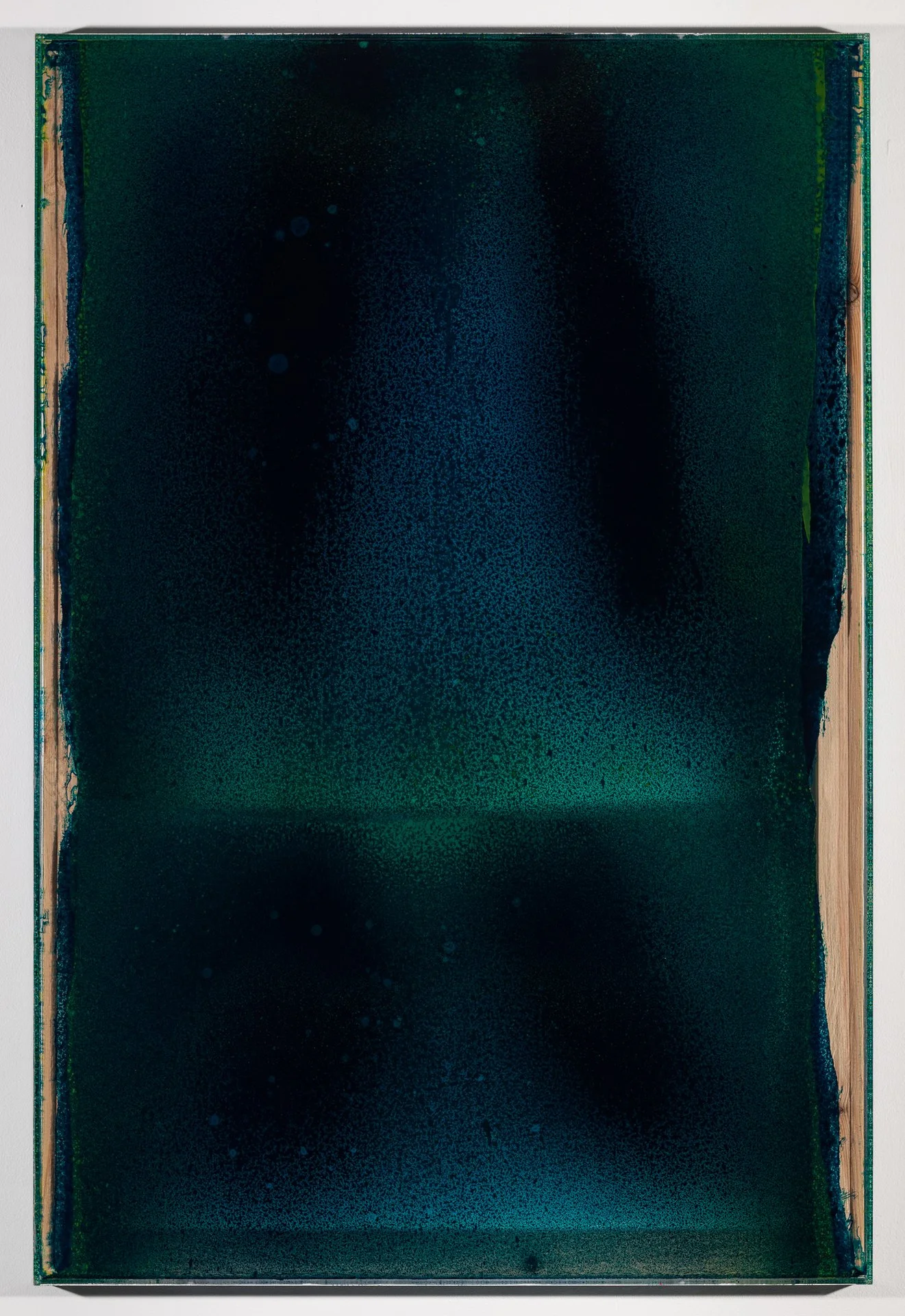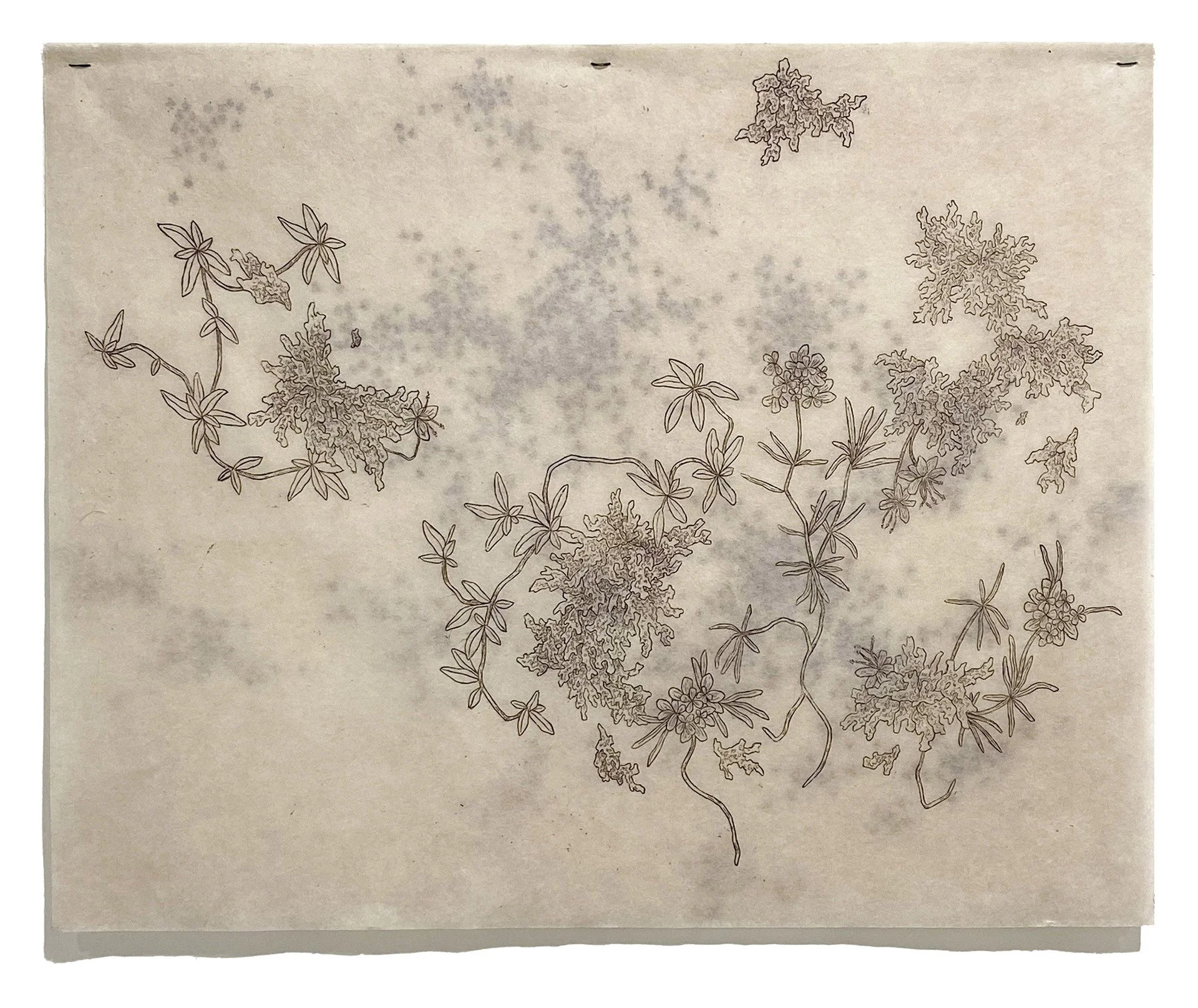Material Process
Juried by Francesca Altamura
About the Juror
Francesca Altamura is a Brooklyn-based curator and the Senior Art Curator at Morris Adjmi Architects..
Wall 1 | Essence | Engaging with material through a traditional lens — honoring the raw, foundational qualities of form, texture, and presence.
Flora Saldivar / Barry Beach / Alesky Cisowski / Emilia Milcheva / Jenna Manzano / Emily Conlon / Mary Connell / Pauline Cordier / Kerry Stevens / Susannah Weaver/ Aydin Hamami / Montana Binder / Geoffrey Litherland
Material is more than just medium—it is memory, force, resistance, and collaborator. The artists on this wall engage with the foundational essence of form, texture, and transformation, often through direct encounters with natural processes and environments. Montana Binder surrenders control to water and light, capturing ephemeral imprints on photographic paper, while Geoffrey Litherland’s frescoes ground pigment and sand into slow, cosmic meditations on landscape. Barry Beach transforms reclaimed wood and synthetics into undulating topographies shaped by chance and geology, and Kerry Stevens channels the elemental force of landscape through poured wax and shellac. Emily Conlon layers etchings with beeswax to hold onto fleeting impressions of place and time, while Aydin Hamami’s stitched assemblages echo the fragile persistence of memory through discarded materials.
Others on this wall emphasize the raw dialogue between material and maker—between softness and structure, repetition and labor. Susannah Weaver’s felted concrete sculptures make visible the tension between wool and cement, creating surfaces that are both fleeting and solid. Pauline Cordier challenges spatial perception through sculptural interventions rooted in site and temporality, while Alesky Cisowski uses reverse-painted Plexiglas to reveal the process of making as a final unveiling. Mary Connell builds paintings from compost and plaster, accumulating lived time into textured surfaces that fluctuate with each layer. Emilia Milcheva embraces clay’s natural imperfection, allowing form to emerge intuitively. Jenna Manzano’s fiber sculptures highlight the meditative power of repetition and subtle texture, while Flora Saldivar’s paintings explore emotional depth through dual-sided mark-making on raw canvas—honoring both material and cultural identity. Together, these works celebrate the essential nature of making: tactile, temporal, and deeply attuned to the quiet intelligence of materials.
Wall 2 | Experimentation | Innovative approaches that challenge, reshape, and reimagine material through process and play.
Dani Hawkes / Deborah Meyers / Merlin Lentz / Oriana Confente / Rosalyn Driscoll / Marion Grant / Brenda Stumpf / Tyler Burton / Yunqian Lin / Rebekah Burgess / Victoria DeBlassie / Lingyi Hu
Through acts of risk, curiosity, and transformation, the artists on this wall reimagine material as something not fixed, but in flux—something to be stretched, broken, deconstructed, and reborn. This is experimentation as a form of inquiry. Yunqian Lin collaborates with water, time, and entropy in her photographic works, allowing nature to deconstruct the image and reconstitute it as something entirely new. Rebekah Burgess floods historical image reproductions, nurturing organic growth on paper to emphasize the fragility of documentation itself. Lingyi Hu’s close-up images of transforming glass defy the expected behaviors of the material, presenting it as a shifting landscape and capturing its uncanny in-between states. Dani Hawkes allows her rusting paintings to continue evolving with environmental forces, giving up control in favor of unexpected material expression. In each of these practices, process is not a means to an end—it is the artwork itself.
Other artists experiment by hybridizing traditional craft with unexpected materials or methods, inviting new sensorial, philosophical, and sculptural possibilities. Deborah Meyers fuses ancient goldsmithing with contemporary textures and gems, bridging centuries through tactile contradiction. Rosalyn Driscoll’s rawhide-based forms hang, float, and writhe—transformed by time, gravity, and touch into organic presences. Marion Grant layers Japanese paper, acrylic, and fabric in shifting palimpsests that invite balance from chaos, while Brenda Stumpf assembles relic-like sculptures from salvaged materials and steeped paper, evoking forgotten rituals and alchemical transformation. Tyler Burton explores the impact of modern life on the natural world, using multimedia installations to question our disconnection from nature. Oriana Confente reclaims analog processes like botanical film development to propose new, care-centered collaborations with more-than-human forces. In a similarly critical and playful way, Merlin Lentz merges animal, machine, and glitch into ambiguous painted forms that blur the boundaries of identity and material. Victoria DeBlassie invites us to reconsider sensory hierarchies by using the hand to recontextualize discarded domestic materials, turning the overlooked into quiet acts of resistance. Across all these works, experimentation is not just a strategy—it is a commitment to uncertainty, reinvention, and play.
Wall 3 | Industry - Unveiling the industrial, technological, and ecological frameworks that drive material use, particularly in relation to human innovation and story.
Caroline Hatfield / Christine McDonald / Shawn Marshall / Juan Granados / Nela Steric / Holly Stone / Norah Stone / Rebecca Murtaugh / Zoe Schwartz / Jamey Hart / Julia Norton / Maria Sol Rodriguez / Charlotte Saylor / Aylin Derya Stahl
Industry is more than a system of production—it’s a framework linking material, labor, ecology, and innovation to the narratives we construct. The artists on this wall expose and examine these systems, showing how industrial processes shape both landscapes and lived experiences. Christine McDonald’s inflatable car-skin sculptures critique planned obsolescence, equating industrial decay with bodily vulnerability. Caroline Hatfield fuses sci-fi and geology to explore extraction and environmental futures. Rebecca Murtaugh uses locally harvested clays to transform ceramics into ecological tools. Maria Sol Rodriguez repurposes lottery tickets into fragile handmade paper, exposing the false promises of hyper-consumption. Each artist engages with industry not as distant infrastructure, but as a deeply human and material force.
Several artists reframe architecture, technology, and archives to reveal emotional or symbolic depths. Shawn Marshall builds surreal architectural spaces layered with memory, power, and transformation. Aylin Derya Stahl documents the slow fading of images in urban spaces, turning visual entropy into cultural commentary. Juan Granados combines clay with digital restoration, grounding memory in material form. Zoe Schwartz merges glass, pearl, and metal into layered ecosystems that explore transformation and ancestry. Jamey Hart gathers materials to examine absence, presence, and the poetic space between. Nela Steric’s chemically altered imagery blends symbolism with everyday residue, evoking personal and collective mythologies. These artists reflect on industry’s ties to perception, emotion, and the shifting boundaries of identity.
Others reshape discarded or everyday materials into visual languages of place and memory. Holly Stone experiments with pleated tissue and light, revealing how perception shifts with illumination. Julia Norton assembles paper, pigment, yarn, and bone into sculptural works rooted in regeneration and care. Norah Stone embeds foraged ecological debris into ceramics that feel relic-like and maternal. Charlotte Saylor turns painting rags and found objects into layered compositions where texture, memory, and form intertwine. These works turn industrial traces into vessels of intimacy—reminding us that innovation is always personal, and material is never neutral.































































































